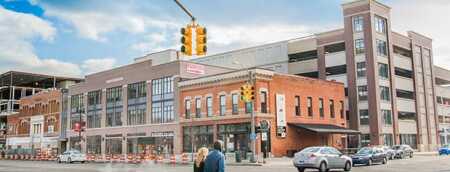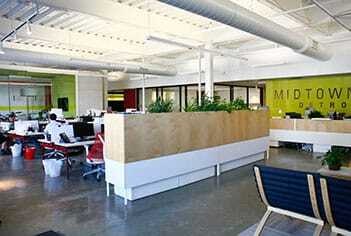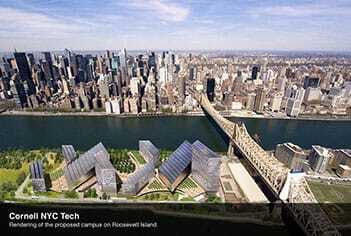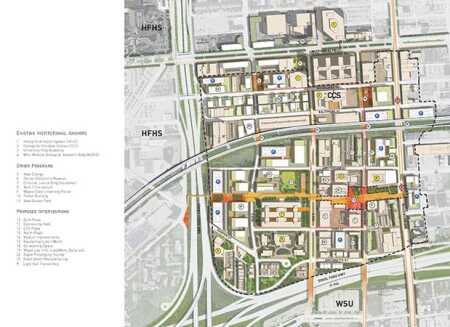Bruce Katz and Jennifer Bradley of the Brookings Institution’s Metropolitan Policy Program are two of the more optimistic voices on Detroit these days. “In midtown and downtown, there’s a sense of incredible energy and optimism,” says Bradley, founding director of the program and coauthor with Katz of The Metropolitan Revolution: How Cities and Metros Are Fixing Our Broken Politics and Fragile Economy. Both spoke in Washington, D.C., last month as part of their book tour.
A combination of private investors and philanthropists is building what Katz and Bradley call an “innovation district.” The “chief architect” of Detroit’s downtown revival is Daniel Gilbert, chairman and founder of mortgage company Quicken Loans. In 2007, he moved his 7,000 employees from Farmington Hills, Michigan, to downtown Detroit. Since then, he has bought 15 buildings and two parking garages there.
Related Content:
- Detroit: The New Paradigm
- Innovation Fuels Cities
- Anchor Institutions Driving Urban Revitalization
- Midtown Detroit – 2013 ULI Global Awards for Excellence Finalist
There are also partnerships between hospitals and educational institutions, such as Midtown Detroit Inc., which has helped bring $1.8 billion in public and private investment to midtown. Business and philanthropic efforts are engaging the broader community, says Bradley. Jobs are being created in health care and small manufacturing for which training will be needed, but not necessarily a four-year degree.
Katz and Bradley say they see hopeful signs in metropolitan areas across the United States. They emphasize that they are talking about metropolitan regions, not just cities, because the partnership between cities and the surrounding suburbs is crucial. One reason they cite is that the federal and state governments are doing less.
“Because of the shock of the recession, these leaders [of metropolitan areas] understand they are on their own,” says Katz. “They’re going to have to move the country forward. Progress is increasingly going to happen in places where people live” rather than through top-down mandates.
The changes the authors see driving the “metropolitan revolution” are at the local level, in these innovation districts found in cities ranging from New York to Denver to Houston. The districts connect anchor institutions with innovative firms and spinoff companies; business incubators; mixed-use housing, office, and retail; and amenities and transit.
One example from the authors: The recent financial crisis made it apparent that New York City’s economy was too dependent on the financial sector. City leaders, working with the nonprofit New York City Economic Development Corporation, saw a need for more technologically skilled workers. In 2010, the city held an international competition and a year later announced that Cornell and Technion–Israel Institution of Technology would build a graduate school on Roosevelt Island. The project could bring as much as $2 billion in private investment and, eventually, tens of thousands of jobs.
Different cities will use their particular assets in different ways. Houston, through nonprofit group Neighborhood Centers Inc., has embraced its immigrant community and worked to bring immigrants into mainstream health care, charter schools, and other municipal services.
“Houston understood that immigrant poverty is a metro problem, not a city problem,” Bradley says.
That lesson can be applied elsewhere. “County and city governments need to be aware of the suburbanization of poverty,” says Bradley. “More poor people live in the suburbs than the city. That has enormous implications for transit.” Transit networks should run not just from suburb to city, but from city to suburb and suburb to suburb.
To help deal with poverty, it is important to disperse affordable housing throughout a metropolitan area so that it is not segregated in low-income areas.
“We need to remake our policies to drive down [housing] costs and move to more economic integration,” says Katz. That would bring back more income integration in schools, he adds.
Another role for city planners in creating successful innovation districts and thriving urban areas is designing neighborhoods with a mix of housing, business, retail, and schools. Midtown Detroit, for instance, has small-scale manufacturing, the College for Creative Studies, and a charter school proximate to each other.
These kinds of changes can help metro areas rebuild their economies, as some have already started to do.
“What kind of economy do we want to build?” asks Katz. “How do we structure our institutions to deliver this? On the local level, people get it.
“The problem is, when we focus on economic development, we think of massive structures like a convention center or a sports stadium. Those are white elephants,” he adds.
Instead, Bradley says cities should focus on production and innovation, but not production in the old sense of an assembly line—that type of large manufacturing plant and the jobs that went with it are gone. Northeast Ohio, for instance, lost tens of thousands of jobs in the 1990s and early 2000s. Cleveland, Akron, Canton, and Youngstown have since banded together, pooled their philanthropic resources, and created the Fund for Our Economic Future. As it grew, it raised millions of dollars to support economic development throughout northeast Ohio. The area now has a cluster of medical device, biotechnology, and medical services firms that has been so successful that companies from elsewhere have moved to the area to be part of it.
“We’re seeing a new geography of innovation,” says Bradley. “It used to be the model was Bell Labs or the Research Triangle—hermetically sealed, isolated, auto-dependent campuses. Now, businesses realize innovation comes from partnership and interactions. They want walkable street grids. The Research Triangle is being retrofitted.”
More broadly, Katz and Bradley are talking about moving from a consumption economy to an innovation economy. Even the way we measure the economic recovery—i.e., by tracking housing starts—is outdated, Bradley says. The recent real estate bubble should remind us of that.
“There’s a better way forward than depending on housing and building, and local consumption,” says Bradley. “What makes the economy grow is the innovations you export.” That is where the federal government has a role—in providing data.
“If the federal government made it easy for every place to estimate [its] export intensity or school-to-career readiness, you really could start to change the import economy,” she says.
Building the innovation economy will not be easy, and it will take a long time. Says Bradley: “It took us 20 years to run out the consumption economy.”
There is a “Metropolitan Revolution” iPad app available for free in the Apple App Store.








